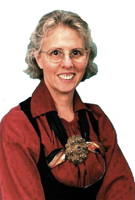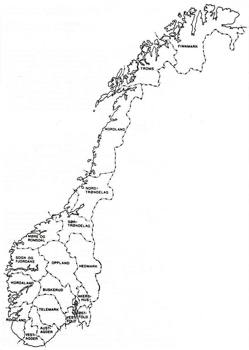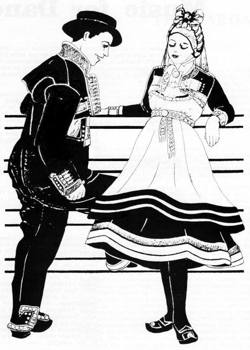
|
The Society of Folk Dance Historians (SFDH)
Norwegian Folk Dances
[
Home |
About |
Encyclopedia | CLICK AN IMAGE TO ENLARGE |

|
BACKGROUND
Information: Norway is one of the Nordic countries, located on what we call the Scandinavian peninsula. It has a population of approximately four and a half million people, is the sixth largest country in Europe, but has the second lowest population density in Europe. Only Iceland has a lower ratio of inhabitants to area. The length of Norway's western coastline is about the same as that of the western United States, from the Mexican border all the way to Alaska. The landscape is that of majestic mountains, valleys and waterways, and its climate is both harsh and heartwarming.
The majority of the population is of Nordic decent. The Sami people (from Lapland) form the largest ethnic minority with some 20,000 people. There are Europeans, Americans, Asians, and Africans making up the rest of the population. The people of Norway are said to be a rather homogeneous population population, unlike the melting pot of peoples and cultures that we have.
Norway is a very rich dance country. There are many different kinds of dances there. Within the folk dance genre, there are four main categories, presented here in chronological order.
The song dance came to Norway around the 1200s. As most all of the dance in Norway, it probably came from Europe. It is thought to be based on the Carole tradition, which was a song dance tradition that used no accompaniment other than the singing. The Norwegians made the song dance tradition very much their own, creating many songs and melodies. The song dances died out in Norway by the early 1800s. At the end of the 19th century, Hyulda Garborg, who was very interested in the old song dance melodies, revived them by creating dances to go with the old songs. A few years later, Garborg went to the Faroe Islands and discovered that the Faroese had a living song dance tradition. When she returned to Norway, she again created dances, this time based on what she had seen in the Faroes. Today, there are numerous song dances in Norway, some based on the old ballads, poetry, and the earliest revived style of dancing, and some based on new songs, poetry, and choreographies. The newer dances may be more reflective of today's styles and interests.
Some of the characteristics and categories of Norwegian song dances follows:
A. Characteristics
- a capella (no musical accompaniment)
- couples dance in a chain or ring, singing
- danced holding hands or forearms
- usually in two parts, or refrain and chorus
B. Categories
- choreographed to old songs, ballads, and poems
- choreographed to new songs and poetry
- "ringleik" – ring/song games
BYGDEDANS (regional/village dance)
Many years after the song dances were established in Norway came the "bygdedans" or regional/village dances. They, too, are thought to have been originated in Europe and migrated to Norway around the 1600s. Klara Semb talks of these newer dances replacing the older form, the song dance. In some regional dances, it seems that instead of replacing the song dance, they are incorporated into the newer format of the regional/village dances.
There is some talk of the "bygdedans" being related to the Ländler. The "pols" dances are thought to have come to Norway via Sweden from Poland. The regional/village dances do not seem to have developed after any one tradition from Europe. There seem to be at least several influences coming from Europe as well as those within Norway that have affected their development. There are five different kinds of regional/village dances:
- 3/4 meter
- found in Østerdalen, Nordmøre, Trøndelag, Nordland, and Troms
2. Springar (Running dance)
- 3/4 meter and asymmetrical 3/4 meter
- found in southern and western Norway, some specific valleys including Son, Telemark, Numedal, Hallingdal, and Valdres
- Around twenty in number, not counting specific local dialects
3. Rull/Rudl (no translation)
- 2/4 and 6/8 meter
- found around Voss and western Norway
- newest member of regional dances
4. Gangar (walking dance)
- 2/4 and 6/8 meter
- found mainly in Setesdal, Telemark, Numedal, and Valdres
- thought to predate the Springar tradition
5. Laus/Halling (loose dance or dance from Hallingdal)
- 2/4 and 6/8 meter
- principally men, often solo
- previously found all over Norway, but mainly in Hallingdal, Valdres, and Østradal
- very athletic and includes acrobatics
- men kick a hat off of a stick held high above their heads
All but the Laus/Halling are couple dances. The "bygdedans" all have distinct regional styles, particularly with regard to the rhythm and "svikt" (the characteristic spring or down-up movement). All are improvisational within the parameters of the dialect, incorporating several to many regionally distinct features. Each dance has its own distinctive style, character, and rhythm. In 1980, Jan Petter Blom wrote, "The term ("bygdedans") refers to a category of folk dances which, in popular perception, constitute the core of indigenous or national dances of Norway . . . Dialect features in general tend to reinforce popjular notions about cultural differences between neighboring communities and function as markers of local identity." I like to think of the "bygdedans" as the heart and soul of Norwegian folk dance.
The "bygdedans" are all usually danced to fiddle music. In the southern part of Norway, it is the Hardanger fiddle, and in the east and north, one finds the regular fiddle accompanying the dances. The Hardanger fiddle or "hardingfele" is a fiddle found in Norway today. The earliest one dates from 1651. Today, the Hardanger fiddle has four or five sympathetic strings, that is, strings beneath the ones played, that resonate while the upper strings are bowed. It also has a flatter bridge than a regular fiddle, and a shorter neck. Usually, the "hardingfele" is elaborately decorated.
Some examples of norwegian "bygdedans" that are in the folk dance repertoire include Vossarul, Rørospols, Telespringar, and Gangar.
TURDANS (figure dance)
After the regional dances had taken a strong foothold, the figure dances arrived in Norway. A few are thought to have arrived as early as the beginning of the 18th century. Some are recorded in a book by Sven H. Walcke in 1802, the earliest known book of dance instructions from Norway (Beal, 1988). They are the kinds of dances that we in America would call Contras, Reels, Squares, and trio dances. There also are choreographed Waltzes and Polkas that fall into this category. The main characteristic of these dances is that they are fixed choreographies. That is, the dance follows a set and repeated sequence each time it is danced. The figure dances are primarily couple dances, with the exception of the trios that are danced to musical accompaniment. The various categories are:
- Kontra – Contras
- Kadrille – Squares
- Tretur – trio
- Ril – Reels
- Choreographed old time dances
- Feiar med vals – sweeper with Waltz
- Pariser polka – Paris Polka
The music for the figure dances may be a single fiddle, Hardanger fiddle, or regular fiddle. It may also be a small band or orchestra including a fiddle, Norwegian flute, guitar, bass, and/or accordion. The melodies used for the figure dances are often found not only within Norway, but all around the European and now American continents. One example is the tune we call "Soldier's Joy," which is the melody for the Norwegian dance Seksmannsril. Pariser Polka and Feiar med Vals are two examples of figure dances that one might find at American folk dancing.
GAMMALDANS (old time couple dance)
The last of the types of folk dancing that we find in Norway is the "gammaldans" or old time couple dance. These are the Waltz, Schottische, Mazurka, and Polka. We find these dances in Europe and also here in America. These are dances that involve couples dancing face to face, attached to one another, and revolving around the room. These dances are sometimes referred to as turning dances. These dances are:
- Vals – Waltz. 3/4 meter
- Polkett – Polka. 2/4 meter
- Masurka – Mazurka. 3/4 meter
- Reinlender – Schottishce. 2/4 or 4/4 meter
- Nygamalt – new/old couple dances (Foxtrot, Latin [Tango, etc.], Swing)
Sometimes, the Springpols, a Norwegian dance that is quite similar to the Swedish Hambo, and the Pols are included in an evening of "gammaldans."
Sometimes the question "What is Norwegian folk dancing?" comes up. We have just had a quick overview of what we here in America call Norwegian folk dancing, but depending on who you ask and where you ask the question, the answer will vary. In Norway, the answer would be that the folk dance of Norway is the "bygdedans" or regional dance. In America, the answer you got would depend on when the person you asked had come to America. It seems that during some time periods, certain of the dance forms were popular and at other times, others were more common. I have found that those who came to America in the early part of the 20th century cited the song dances as "the" folk dances. Later, it might have been the figure dances. The answer also would depend on where the individual you asked grew up. Ingvar Sodal, one of my Norwegian dance mentors, grew up on a farm in Trondelag, and learned to dance "pols" and "gammaldans" in the barn from one of his older sisters. His family had dance in their traditions.
Many families may not have dance in their tradition. Often, children growing up in the urban centers come to dance later in life. They come from many different reasons. Some come for a chance to learn what their relatives dance or danced, and to learn more about their regional heritage. Others come to dance for social reasons. The percentage of Norwegians that dance is somewhere between four and ten percent of the total population. Many of the dancers know one another even if they live in different parts of the country. Many travel to the different festivals, concerts, and competitions or participate, dance, and see friends.
DOCUMENTS
- About Norway, a country.
- Choreogeography: Scandinavia, an article.
- Historical Notes on the Norwegian Rørospols, an article.
- Norway, a country.
- Norwegian Dance, an article.
- Norwegian Folk Dances, an article.
This page © 2018 by Ron Houston.
Please do not copy any part of this page without including this copyright notice.
Please do not copy small portions out of context.
Please do not copy large portions without permission from Ron Houston.

